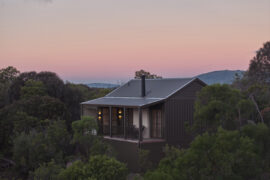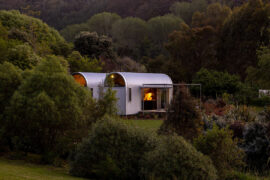We spoke with Jeffrey Wilkes of WILKESDESIGN about the John Portman-designed building, which has been infused with touches of local culture and colour.

April 8th, 2024
When Mandarin Oriental, Singapore opened in 1987, DESIGNWILKES worked on the design of the Club Lounge. The Kuala Lumpur-based design studio helmed by Jeffrey Wilkes returned eight years ago for some slight refurbishment. The past year, it was engaged to revamp the entire hotel, taking six months to breathe new life into every part of the iconic building designed by US architect John Portman. The hotel re-opened in September after the USD100 million-dollar renovation.
“The main direction was to create a lively interior that was connected to Singapore, to increase the sense of place and lighten the environment,” says Wilkes, who founded his eponymous design studio in 1994. It has since created many lively hospitality spaces, such as Mandarin Oriental properties in Bangkok, Tokyo and Kuala Lumpur, W Resort in Goa India and Anantara Siam in Bangkok.

For the interior design, Wilkes referenced Peranakan architecture, black-and-white colonial houses and Angsana trees native to the island. Guestrooms feature dappled batik patterns and are given colour palettes that match their respective views of water or greenery.
Vanda Joaquim orchids (Singapore’s national flower) inspired the crystal spheres in the lobby lounge while the hotel’s transformed lounge, HAUS 65, presents a new concept in the regional hotel scene. The exclusive social space is co-curated by the Mandala Club. Its members can access the activities planned here, as well as use the hotel’s facilities.
Here, Wilkes shares more about the hotel’s design.
How did you get into design and the hospitality field?
Jeffrey Wilkes: I’ve been [aware of] interior design since I was a kid. I was very conscious of my surroundings. When I was 10, I asked my parents for black-coloured carpets. They said it didn’t exist, but I thought otherwise. After obtaining a Bachelor of Fine Arts, I went on to get a Bachelor of Applied Arts in Interior Design. From there, I worked in the luxury condominium sector in Toronto before moving to Asia where I started working in Singapore in 1992, then Kuala Lumpur in 1994. I love the breadth of the hospitality industry – I have been working in this sector for the last 31 years.

Can you describe the DNA of DESIGNWILKES?
We enjoy creating eclectic interiors, [matching] antiques with something contemporary; creating a collection, whether its furniture or art. We take our clients’ desires and [interpret] them into timeless, elegant, functional spaces.
Can you point out some interesting details in the guestroom design? What did you want travellers to feel when they are in this space?
We wanted them to feel they are in Singapore, and we also wanted to maximise the physical space. Heavy drapes were replaced with electric blinds to totally open the view. We also used cerused oak [for the joinery], which speaks to a tropical resort atmosphere. A Chinese-inspired minibar feels like it came from a shophouse and the carpet pattern looks like the shadows of palm trees on the beach.
Related: Hotel Indigo Kuala Lumpur on the Park

Can you elaborate on the design of the Royal Penthouse? How is the design both functional and luxurious?
The Penthouse is an extension of all we were creating in the rooms and suites, but with the addition of incredible views and space. There is a fabulous chef kitchen just waiting for a guest chef, a casual yet elegant living room with oriental touches, a large primary bedroom with an oversized en-suite bath, and a balcony with panoramic views of the Marina Bay area. All these make for a fabulous entertainment suite.
How does the interior design of HAUS 65 present a unique space within a hotel while also expressing the spirit of Mandarin Oriental?
Our vision from the start was that HAUS 65 would be [designed like] an apartment or a penthouse with a strong residential feel. We wanted to remove the corporate atmosphere associated with many typical hotel club lounges. Hence, we had planned from the start a mix of furniture and a collection of art. This direction also complements well with Mandala Club’s design style – the guest profile is both corporate and leisure, so it was important to make it work for both sectors.
DESIGNWILKES
designwilkes.com
Photography
Courtesy of Mandarin Oriental Singapore






More ideas about hotel and hospitality design in this exclusive interview with W Hotels’ Global VP
INDESIGN is on instagram
Follow @indesignlive
A searchable and comprehensive guide for specifying leading products and their suppliers
Keep up to date with the latest and greatest from our industry BFF's!

A curated exhibition in Frederiksstaden captures the spirit of Australian design

The undeniable thread connecting Herman Miller and Knoll’s design legacies across the decades now finds its profound physical embodiment at MillerKnoll’s new Design Yard Archives.
The new range features slabs with warm, earthy palettes that lend a sense of organic luxury to every space.

Gaggenau’s understated appliance fuses a carefully calibrated aesthetic of deliberate subtraction with an intuitive dynamism of culinary fluidity, unveiling a delightfully unrestricted spectrum of high-performing creativity.

In what is already a peaceful idyll on the Mornington Peninsula, Kate Walker has crafted an intimate retreat with new villas for overnight stays at Alba.

Projects and people from across our region were certainly prominent at the 2025 INDE.Awards gala and in particular, Aotearoa/New Zealand, Singapore and Thailand made their presence felt.
The internet never sleeps! Here's the stuff you might have missed

The Arup Workplace in Perth/Boorloo, designed by Hames Sharley with Arup and Peter Farmer Designs, has been awarded The Work Space at the INDE.Awards 2025. Recognised for its regenerative design, cultural authenticity, and commitment to sustainability, the project sets a new benchmark for workplace architecture in the Indo–Pacific region.

In what is already a peaceful idyll on the Mornington Peninsula, Kate Walker has crafted an intimate retreat with new villas for overnight stays at Alba.